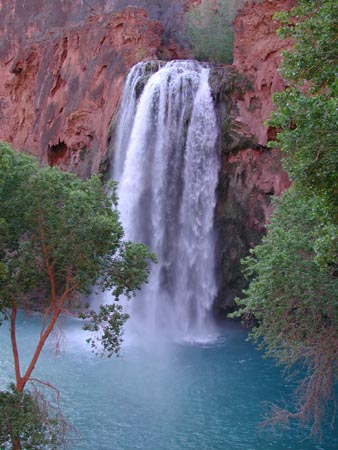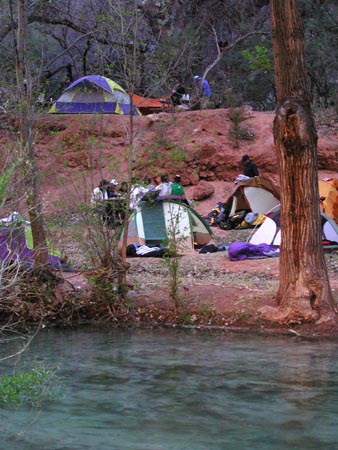See our Havasu photos.
2017 Note: People who have visited Havasu Falls recently tell me the area has been cleaned up and is much nicer than what I encountered.
By Dave Webb
When I dream of paradise I visualize a turquoise waterfall with a deep, clear, cool plunge pool, surrounded by blond sand and lush vegetation. Over the years, as I saw photos and hear descriptions, Havasu Falls came to epitomize paradise in my mind and I looked forward to trekking there, to enjoy its sanctuary under the formidable walls of the Grand Canyon.
I made the trek recently and found the waterfalls to be every bit as beautiful as I had visualized. I was disappointed, however, because the canyon was overcrowded and trashed. I don’t think I’ve ever hiked a trail strewn with more litter.
Havasu is a popular destination for families and youth groups. It could (should) provide an incredible experience but, in its present condition, I have to give it a mixed review. It is worth the trip, but read on for the disclaimers.
Havasu Creek offers a series of waterfalls in a rugged canyon some 10 miles from the nearest road. You get there by backpacking, or packing in with horses or mules. But it is not a typical backpack experience and it is definitely not a wilderness experience. It’s more like Disneyland in the Grand Canyon–fun and exciting but there are people everywhere and the lines are too long.

The stream flows out of limestone, which gives it a pleasing blue-green hue. The waterfalls have created large plunge pools that are clear, deep and inviting. People come from around the world to view the waterfalls and Grand Canyon scenery, and to swim in the pools.
The area is part of the Havasupai Indian Reservation and is managed by the tribe. The number of visitors is restricted and reservations are required. See the tribe's website for contact numbers and information about making reservations. You must apply months in advance for trips during the tourism season.
May/June and September/October are the best months to visit if you want to play in the water. Hiking conditions are excellent earlier in the spring and later in the fall, but the water is cold and less inviting. The water is delightful during mid-summer but hiking conditions are hot.
You must hike/backpack or ride horses to reach the waterfalls. From the trailhead it is 8 miles to the Havasupai village of Supai, where you check in at the tourism office. You can also buy basic supplies, food and drinks in the village.
Havasu Falls, the most famous of the waterfalls, is located 2 miles below the village. Mooney Falls is about a mile further down the trail. A campground is located along the stream between those two waterfalls. Most tourists camp but some elect to stay in the lodge in the village. The village also offers a small cafe.
All supplies brought into the village and campground come by backpack, mule train or helicopter. The village receives mail by mule train. Because of its remote location, supplies in the village are more expensive than similar items at your local grocery store.
The 10-mile trail from the trailhead to the campground is steep, particularly on the upper end. It is also rocky and in some spots it is fully exposed to the summer sun. Backpacking is strenuous. Many visitors elect to have their packs carried in by mule trail. Some pack in but then have the mules carry their gear out.
 The trailhead is called Hualapai Hilltop. It is located at the end of Indian Road 18, 60 miles north of the Junction of Road 18 and Hyw 66. The junction is between Seligman and Peach Springs, in northwest Arizona. This is a remote area about 235 miles east of Las Vegas and about 165 miles northwest of Flagstaff, AZ. Some computer/internet map programs show alternate routes to the Hilltop but those are rugged reservation backroads not open to tourists. Indian Road 18 provides the only reliable access.
The trailhead is called Hualapai Hilltop. It is located at the end of Indian Road 18, 60 miles north of the Junction of Road 18 and Hyw 66. The junction is between Seligman and Peach Springs, in northwest Arizona. This is a remote area about 235 miles east of Las Vegas and about 165 miles northwest of Flagstaff, AZ. Some computer/internet map programs show alternate routes to the Hilltop but those are rugged reservation backroads not open to tourists. Indian Road 18 provides the only reliable access.
Drinking water is available from a spring in the campground. Water obtained from the stream or other sources should be purified. Water is not available along much of the trail into the canyon, so people hiking in or out of the canyon need to carry at least 2 liters per person.
Springs in the area are warm, approximately 70 degrees year round. That includes Fern Spring, which provides drinking water in the campground. The water has a slight mineral taste.
When I backpack I normally expect to get away from it all, into the wilderness where I can enjoy solitude and pristine conditions. Here you pack for 8 miles and come to a village where you can buy cold soda pop and ice cream bars.
You pack 2 more miles and come to a crowded campground where there are kids everywhere.
Porta-potties are provided at the campground but there is usually a waiting line. They fly porta-potties in and out via helicopter occasionally, but they are often full and smelly.
I found it interesting to watch the mule trains bring supplies into the canyon. I had envisioned a handler leading the train, tugging on halters to get the stubborn animals to move down the trail. But I never once saw a handler coax or prod the mules. Most of the time the handler rode behind them. The mules just trotted down the trail, knowing exactly where to go, and seemed willing to do their share.
Mules and horses come down the trail frequently and so you’ve got to watch where you put your feet as you hike.
I’m sure most, but not all, of the litter in the canyon comes from careless tourists. Leaders probably give pep talks to youth groups, encouraging them to be responsible guests. But when the groups hike through the village and see junk piles in people’s yards, the example is not positive. While I’m not excusing thoughtless tourists, part of the litter problem apparently comes from the stewards of the canyon.
The village of Supai has been home to the Havasupai people for many hundreds of years. It is perhaps the most isolated community in the lower 48 states. If ever a people could have resisted many of the encroachments of modern society, could have retained many of their traditional ways, it was these people. I couldn’t help but notice that many homes have satellite TV and many kids walk around with iPods.
They choose to live in Supai, in a remote canyon with magnificent waterfalls. But I believe they are exploiting this paradise for tourism dollars. I would have gladly paid twice as much to visit a canyon with half as many tourists, and no litter.
Still, the scenery is spectacular. The waterfalls and plunge pools make the trip worthwhile.
Copyright Dave Webb
